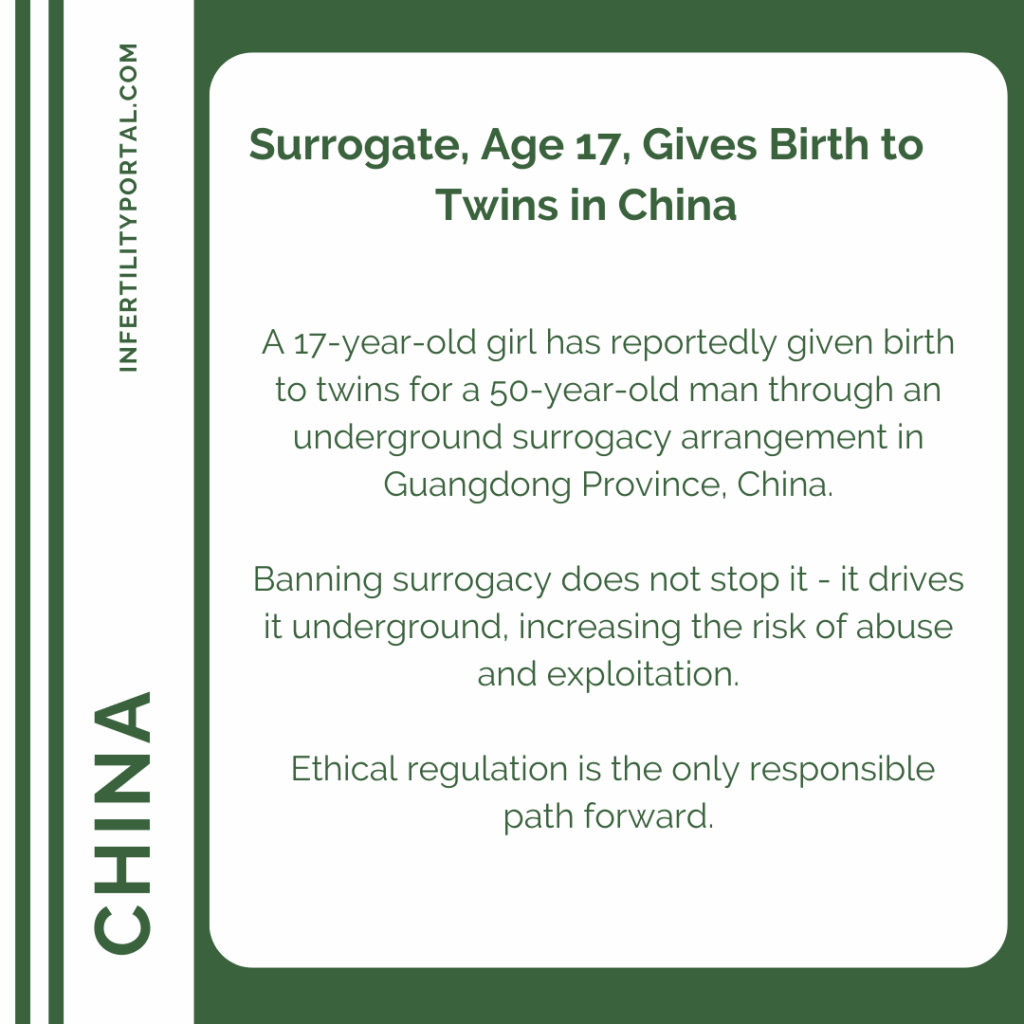When Surrogacy Is Driven Underground: The Disturbing Case of a 17-Year-Old Surrogate in China
A recent report from Guangdong Province, China, has reignited global concern over unregulated and underground surrogacy practices. A 17-year-old girl has reportedly given birth to twins through a surrogacy arrangement.
According to Chinese media, local authorities have confirmed the birth and launched an investigation. The young woman, who was already in labor when she arrived at the hospital, claimed she had not been coerced and provided details about the intended father. However, beneath this surface claim lies a disturbing truth: the girl was only 16 years old at the time the embryo was transferred into her body.
This case has sparked outrage, not just for the girl’s age, but for what it reveals about the absence of legal protections in jurisdictions where surrogacy is banned or unregulated.
Bans Do Not Stop Surrogacy — They Push It Into the Shadows
China currently bans commercial surrogacy, and cases like this are not isolated. Surrogacy still happens, it just happens underground, without oversight, safeguards, or ethical accountability. In such environments, vulnerable women, often young, poor, and under-informed, are recruited into dangerous and exploitative arrangements.
In this case, reports allege that the surrogacy was brokered by a Guangzhou-based agency, which also offered gender selection, priced egg donors based on education level, and promised a smooth path to twin births. All these activities are completely outside the bounds of regulated medical ethics. With no government-approved guidelines, no independent legal representation, and no psychological screening, the surrogate was left without basic protections.
The Illusion of Consent
Some may point to the girl’s statement that she was not coerced. But in reality, true consent cannot exist in a vacuum.
Consent, in ethical surrogacy arrangements, must be:
-
Informed
-
Voluntary
-
Supported by legal and psychological professionals
Anything less is exploitation, even if no one holds a weapon or signs a forced contract.
What Ethical Surrogacy Looks Like
Surrogacy, when properly regulated, can be a beautiful act of generosity. For decades, countries like the United States have demonstrated that it can be done ethically and safely if the right standards are in place.
Best practice surrogacy includes:
-
A minimum surrogate age of twenty-one, with a history of prior birth
-
Mandatory independent legal counsel for the surrogate
-
Psychological screening and ongoing counseling
-
The surrogate’s right to choose the intended parent(s)
-
A ban on anonymous arrangements
-
Full transparency, medical oversight, and enforceable contracts
These are not optional extras, they are the baseline requirements to ensure dignity, protection, and ethical integrity for everyone involved.
The Real Risk Is Inaction
This case is not an argument to ban surrogacy. On the contrary, it is a wake-up call to move beyond vague prohibitions and moral panic. Banning surrogacy does not prevent it from happening. It simply ensures that it happens in silence, without scrutiny, and without safeguards.
The real danger lies in pretending that prohibition is protection.
Final Thoughts
The birth of twins to a 17-year-old surrogate in China is not just a shocking headline, it is a human tragedy rooted in policy failure. If countries want to protect women, children, and families, they must move toward transparent, ethical, and enforceable surrogacy laws.
It is time for governments to recognize that ethical regulation, not criminalization, is the only way forward.


